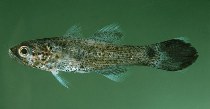| Family: |
Apogonidae (Cardinalfishes), subfamily: Pseudamiinae |
| Max. size: |
11 cm TL (male/unsexed) |
| Environment: |
reef-associated; marine; depth range 1 - 64 m |
| Distribution: |
Indo-Pacific: Red Sea and East Africa to French Polynesia, north to Ryukyu Islands, south to Sydney Harbor, New South Wales (Australia). Not yet reported from the Persian Gulf, India, Malaysia, Lord Howe Island, Hawaiian Islands, Marquesas Islands, Pitcairn Group, and Easter Island (Ref. 526). Recently recorded from India (Ref. 45255). |
| Diagnosis: |
Dorsal spines (total): 7-7; Dorsal soft rays (total): 8-8; Anal spines: 2-2; Anal soft rays: 8-8; Vertebrae: 24-24. This species is distinguished by the following characters: dorsal fin rays VI-I, 9; anal fin rays II, 8; pectoral fin rays 15; pelvic fin rays I, 5; pored lateral line scales 35; predorsal scales 5-6; circumpeduncular scales 12; total gill rakers 11, developed gill rakers 8 (Ref. 093839); body translucent when fresh; sides and ventral part of head light golden to silvery iridescent; head and body with large brown spots with golden dot on the center; dusky peritoneum with numerous black dots. Anterior nostril with long, darkly pigmented membranous flap. Dorsal part of caudal fin sometimes with an indistinct dark spot. 39-43 scales in longitudinal series. This species has fewer gill rakers and anal fin rays than P. amblyuroptera (Ref. 37816). |
| Biology: |
Inhabits protected bays and lagoon reefs. Lives deep in coral thickets, thus is seldom seen by day (mainly nocturnal). Solitary (Ref 90102). |
| IUCN Red List Status: |
Least Concern (LC); Date assessed: 05 February 2021 Ref. (130435)
|
| Threat to humans: |
harmless |
Source and more info: www.fishbase.org. For personal, classroom, and other internal use only. Not for publication.

